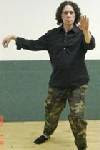MANHATTAN, New York (September 8, 2008) >> mad men virtuality
‘The Gold Violin’ is a story authored by Sterling Cooper staffer Ken Cosgrove (within the episode of the same name) that was inspired by a painting and “was perfect in every way except it couldn't make music." Like the Taoist peeling of an onion's skin, we explore new layers on ‘Mad Men.’ Certain individuals, especially Don Draper, begin to learn deeper relational and hierarchical truths they might prefer not to know. Moral consequences – past and future – are revealed in a mosaic of exterior/interior tensions laid out in layers of both subtle contained strokes and loud colors of emotion.
DISCLAIMER: The essay below contains plot spoilers about Season 2, Episode 7: ‘The Gold Violin.’ If you haven't seen that episode, check out the Mad Men schedule on amctv.com to see when encore presentations are airing or download it from iTunes.
There is a delicious mixture of senses and revelations in ‘The Gold Violin’ episode. Our characters act out vignettes inside a larger collage of immense emotional and dimensional depth "like looking into something very deep - like you could fall in.” The ‘Mad Men’ series reveals itself once more to be a contemporary version of the Medieval Morality Play. Simply put, “morality plays have a protagonist who represents either humanity as a whole, i.e., Everyman, or an entire social class (e.g., Don Draper). Antagonists and supporting characters are not individuals per se, but rather personifications of abstract virtues or vices.” (Source: Wikipedia)
The new Coupe de Ville Cadillac announces the arrival of Don Draper (Jon Hamm) as a made man. In addition, Bertram Cooper (Robert Morse) reveals to him that it’s “time for the horse to catch the carrot.” Cooper piles up the frosting on the cake: “You’re going to be wearing a tuxedo a lot more. You’ve been invited to see how things work.” Don is climbing into a new stratum of what Vance Packard defines in “The Status Seekers” (1959) as the Upper Middle Class.
Don’s status points include the new Caddie, the senior executive and partner rank at Sterling Cooper, the picture book family of college-educated Betty and the kids, the house in the suburbs, etc. Name your own points: ______.
The irony is that Don (wearing a tux) is soon confronted by Jimmy Barrett’s (Patrick Fischler) angry accusation that he has been sexing it up with his wife Bobbie. Jimmy drags Betty Draper (January Jones) into the fray forcing her to see what’s going on, “Oh come on. Look at them.” Jimmy doubles down and calls out Don to his face, “You know what I like about you? Nothing. And what did you get? Bobbie. Lots of people had that. I go home at night and I laugh at you. You don't screw another man's wife. You’re garbage. And you know it.” Jimmy closes, “It’s been a gas.”
Betty Draper transitions from being thrilled at the new Cadillac (“gorgeous -- like a jet”). She strokes Don’s ego: “You work so hard, you deserve it." She enjoys life as their whole family shares a sunny picnic together. At the Stork Club, Jimmy forces her to see Don and Bobbie as mutual spousal cheaters until it makes Betty sick in the fresh car (with an assist from too much champagne).
Salvatore Romano’s (Bryan Batt) marital relationship with his wife Kitty (Sarah Drew) is the simplest version of everything’s perfect but it won’t play music. Ken Cosgrove (Aaron Staton) seems to be putting himself into a situation in which sexual seduction (with flattery) by Sal might naturally flow going forward.
Joan Holloway (Christina Hendricks) discovers that her presumed authority as office manager has been quickly trumped by Jane Seigel’s (Payton List) attractiveness. Roger Sterling (John Slattery) weighs in as the arbiter and master of the realm to Joan’s chagrin. Sleazy business awaits. As we expect events to further unfold for that troika… each of us run has permission for our imaginations to run wild and ragged.
Two pieces of art (the painting and the metaphoric violin) provided the anchors for this episode in which we see and hear dimensional depth of the characters emerge. More specifically, depth is intentionally referenced twice. First, Smitty (Patrick Cavanaugh) remarks on the 60-page Students for Democratic Society screed – it’s a generational thing so you have to be into it to get it. Second, the abstract expressionism of the Rothco painting creates a visual illusion that makes you look into it. An additional reinforcement is that the Sterling Cooper staffers have to sneak into the sanctum of Cooper’s office to see this hidden art object.
It is worth noting for regular readers that the ‘Mad Men Virtuality’ essays are primarily focused on the psychological dynamics and dramatic tensions and resolutions rather than the “look” or culture referencing of the show. As Bertran Cooper cautions, "Don't concern yourself with aesthetics. You'll get a headache.” c2008 by M.L.Duby ///
Subscribe to:
Post Comments (Atom)

1 comment:
wondeful!!!this whole information is absolutely useful and interesting. i like this blog because is easily understandable, and that is invaluable to the readers. I wanted to buy viagra online, and i saw this blog. I think this information will be useful for me specially because I want to get a great stereo and take advantage about it.
Post a Comment